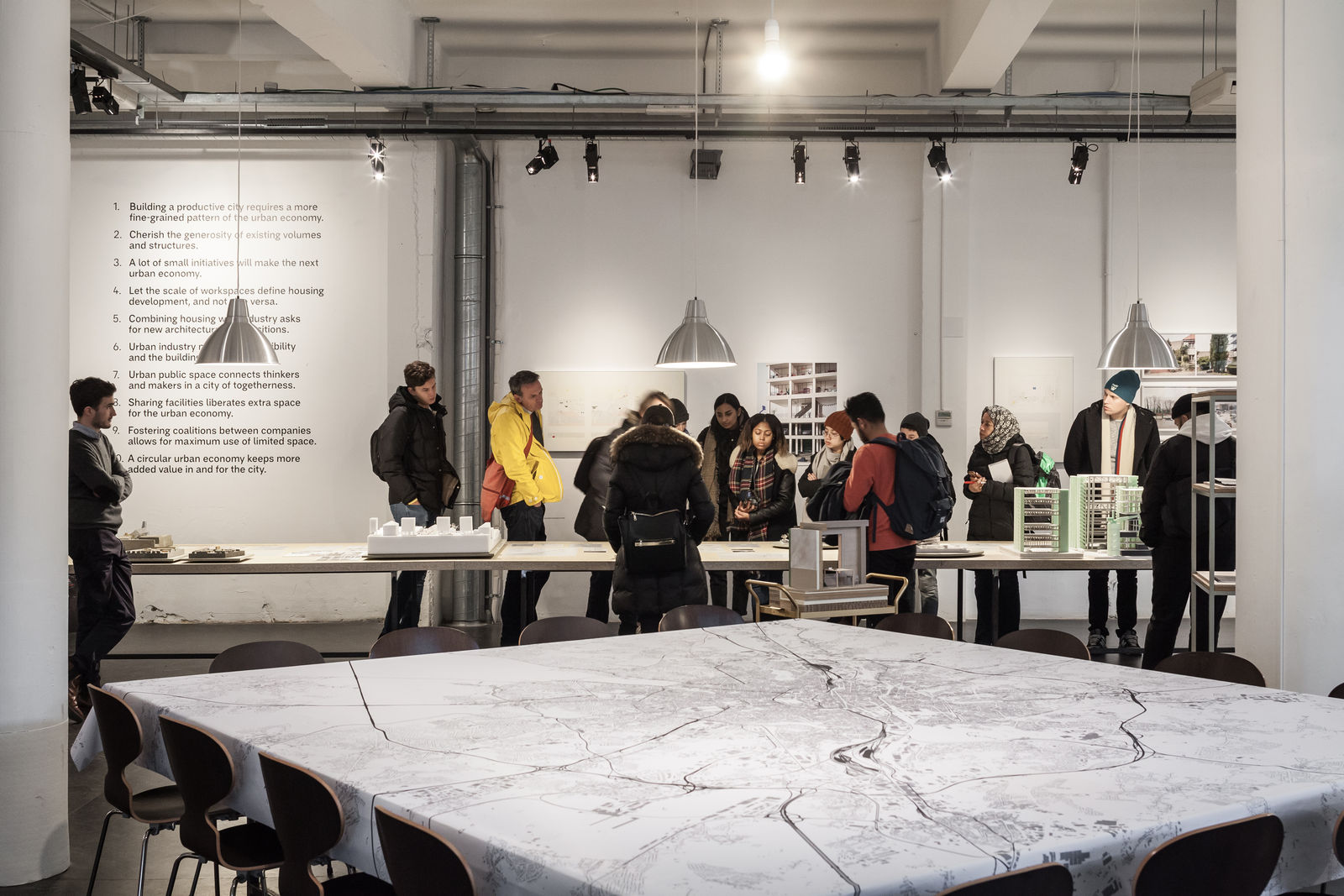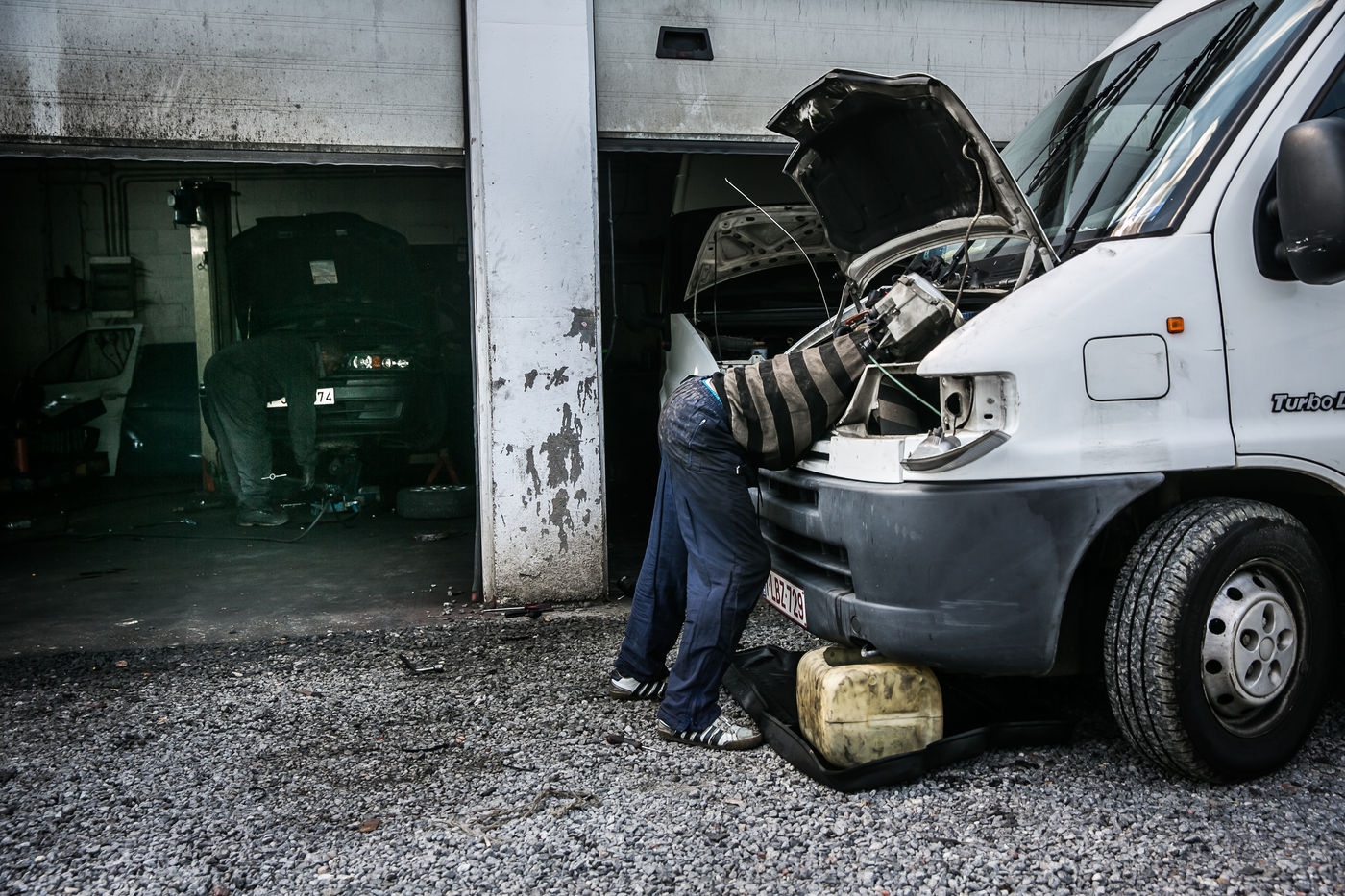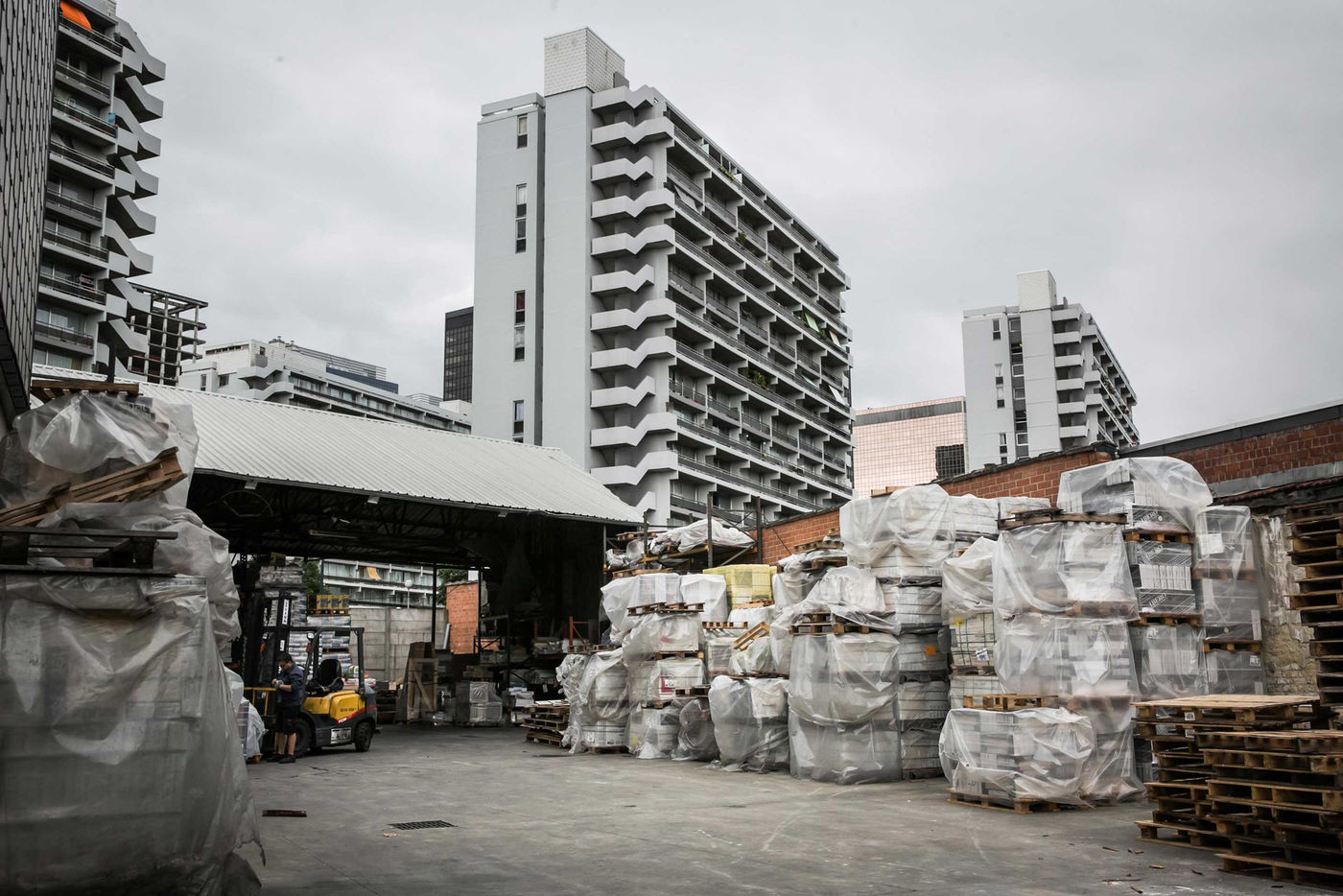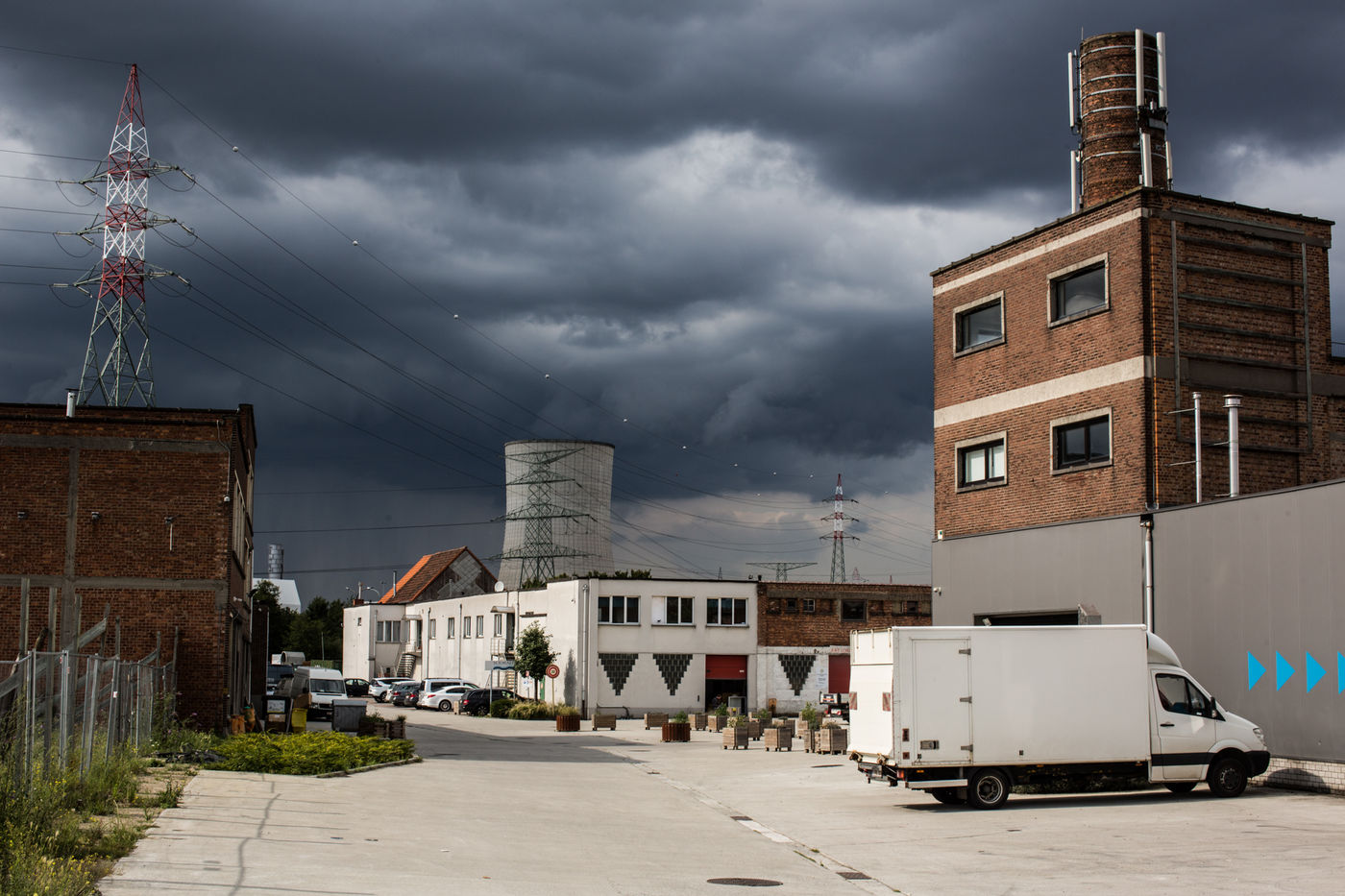
A new trend is emerging in our cities. All over Europe cities are once more making room for the manufacturing economy. The realisation has dawned that a sustainable, efficient city offering a good quality of life needs economic activities, industry and manufacturing.
A Good City Has Industry, is the provocative title of an exhibition we organised in Brussels in 2016. That was four years ago, when such an idea was tantamount to sacrilege. What do we mean, a city needs industry? Didn't we do our utmost in recent decades to clean up the city and transform abandoned industrial sites into hip, vibrant urban districts? Wasn't our aim to restore the quality of life in cities, free of pollution or the din of trucks? And wasn't our economy irrevocably transformed into a tertiary economy? Manufacturing was something based in low-wage countries, wasn't it?
The wave of urban renewal that had washed over all European cities – with success – since the Nineties, featured one major blind spot. The transformation to the post-industrial city failed to consider that not everyone is able to work in the tertiary economy. The large group of low-skilled people in our cities were no longer able to find employment in the city. Another aspect was overlooked, the fact that in order to function a city needs a manufacturing economy, logistics, supply structure, food production, construction materials and so on.
The exhibition A Good City Has Industry represented an important juncture, and set in motion an extraordinary dynamic. We organised debates, lectures and workshops, we led and supported studies and research by design. It was an eye-openerfor policy-makers, architects, developers, academics and students. It gave rise to a great many projects, not only in Brussels but also in other cities.
The productive city does not herald a return to the nightmare scenario of the 19th-century industrial city with its pollution, degradation, exploitation and poverty. Industry itself has changed, and this change will be even more radical during the course of the 21st century. The circular economy is gaining ground. It is urgently needed because energy and raw and other materials are becoming increasingly scarce and costly. In light of climate change, the long transport chains of the current global economy no longer appear to be sustainable. New and shorter logistics chains, the proximity of production and consumption, the reuse of materials, new forms of energy generation and new production methods, such as CAD/CAM, offer the opportunity for creating a sustainable spatial economy in our cities.
Our aim of the productive city theme is to prepare our cities for these transitions. We are seeking ways in which we can embed the economy of the future precisely where it is needed, which is in the city and not outside the city. After all, a productive city is a sustainable, healthy and social city.

The exhibition A Good City Has Industry, organised in 2016, represented an important juncture and kicked off a period of acceleration. However, the theme of the productive city had already been creeping up on us rather surreptitiously. Looking back at 2010, the year Architecture Workroom Brussels was launched. An anthology of projects related to the theme of the productive city provides a good idea of how our practice has evolved over the years. A chronology, with the first phase: setting the agenda. We were able to place the theme on the agenda thanks to a multiplicity of studies, publications and cultural events, inherently in association with diverse actors.
In the exhibition Building for Brussels (BOZAR, 2010) we studied the way in which architecture and urban planning could make a contribution to a sustainable transformation of the city. We presented an impressive collection of best practices from different European cities. Part of the exhibition was dedicated to the economy. The question was: How can architecture support the local economy? We remember how difficult it was to find good examples. They were displayed in the smallest exhibition room and made up the shortest chapter in the book published to accompany the exhibition. Nevertheless, the challenging search really got us thinking. Why does the dominant urban development culture drive the local manufacturing economy and logistics out of the city? While the rate of unemployment in cities is so high, and the city is the main market for goods? This intuition had us firmly in its grasp. A new, urgent work field had been exposed.
First of all we set to work in our home city. The Thinkers vs Makers map, compiled as part of the IABR 2016–The Next Economy, is a further interpretation of the cartographic study launched as part of the Building for Brussels project. Thinkers vs Makers revealed Brussels to be a dual city: to the west of the canal it was a poor city with high unemployment, and to the east a wealthy city with a highly-skilled population. The west was still home to lots of industrial sites, some still operating, others derelict; the east housed an office district where the tertiary economy flourished. The map shows that there is a distinct but problematic relationship between space and the economy. We used an earlier version of the map to focus the ambitions of the Brussels Canal Plan. How could we apply spatial policy to serve economic and social policy?
In 2013, we were involved in designing the Brussels Canal Plan by the French urban planner Alexandre Chemetoff. The Canal Zone is one of the most problematic districts in Brussels. It is the part of the city where many newcomers arrive and end up settling. It has high unemployment and population pressure and a lot of poverty. The Canal Plan aspired to give the troublesome districts in the Brussels Canal Zone a new lease of life. The Region wanted to have a master plan drafted for this purpose and launched a design competition. We guided the commissioning party through the procedure and in drafting the specifications. Traditional specifications for urban renewal projects during this period generally lacked any protection or boost for economic activities in the city. During the early phase of the Canal Plan the aim was also to create as much space as possible for additional housing. The old industrial sites risked disappearing and making way for chic lofts for the middle class, which threatened to drive out the existing population. We gradually succeeded in reversing this trend. Stimulating the manufacturing economy was an important criterion in the specifications. The understanding had grown that we also needed to create space in the city for economic activities and employment.
The Canal Plan was not developed without the residents’ involvement. Since 2010, together with the Platform Kanal and the Kaaitheater, we have worked on a cultural event to involve the population and local associations in formulating a vision for the Canal Zone, and gathering input related to their needs. One of the interventions we achieved was the temporary pedestrian bridge spanning the canal in 2014, designed by Gijs Van Vaerenbergh. The bridge has an important symbolic value. It was the first ever connection between the districts to the north and south of the canal. The canal is no longer a hard border, but a shared space that connects the city of makers to the city of thinkers.


It is easy to say that a city needs manufacturing, but how do you make space for this urban economy, in its true colours? Researchers, architects, policy-makers, investors, project developers and citizens were increasingly won over by the idea of the productive city. It had captured people's attention. But now that the theme had been placed on the agenda, the time was ripe for the next step, which involved research by design. Where, how and for whom do we make room for economic activities? The beginning of this phase more or less corresponded to the run up to the IABR 2016, the research biennale in Rotterdam devoted to the Next Economy. We acted as atelier master with our team. The new research field attracted international expertise, financial resources and test locations.
Our meeting with the British architect Mark Brearley was a game changer. While we primarily viewed our home city of Brussels as a city with hundreds of problems, Brearley called it a ‘city of miracles’. Brussels, unlike other European cities, has quite an extensive urban economy, and, as Brearley says: A Good City Has Industry! Later we used this provocative statement as the title of an exhibition we organised in 2016, in the Ravenstein Gallery in Brussels. On the occasion of the IABR 2016 – The Next Economy, OVAM produced a film with Mark Brearley in the main role.
The 2016 edition of the IABR in Rotterdam was devoted to The Next Economy. In our capacity as atelier master we were involved in the cultural event in Rotterdam and also contributed with a mini-exhibition in Brussels, in which we included a screening of the film with Mark Brearley. The exhibition pointed out the importance of cultural production for our practice. But that wasn't all. The IABR is also a work biennale. During a three-month period, lectures, debates, guided tours and design ateliers took place almost daily. This enabled us to increase the enthusiasm of a broad audience of policy-makers, professionals, academics and students with regard to the new vision of the productive city.
From September 2016 to January 2017, we organised an exhibition together with lots of partners in the Brussels Ravenstein Gallery at BOZAR. A Good City Has Industry featured in large letters on the gallery’s windows, along which thousands of commuters pass every day. Among other things, the exhibition displayed the research by design carried out by several architectural firms into a number of precarious industrial sites in Brussels. The exhibition's visitor guide concisely sums up the most important insights of the research by design into the productive city in Brussels. The booklet provides the keys for building the productive city using ten rules of thumb.
Unlike many other European cities, there is still a lot of economic activity and industry embedded in the urban fabric of Brussels. Photographer Bas Bogaert went in search of it in the districts of Brussels and produced an impressive reportage that shows a diversity of industry, logistics, crafts and new economies. The photo reportage was displayed at the exhibition A Good City Has Industry.
This map goes one step further than the Thinkers-vs-Makers map. It's a process that has taken years, and is still not finished. The map lists and classifies every company in the Brussels-Capital Region. It fills a missing link that many cities struggle with, namely their difficulty in connecting their spatial and economic policies. Only when they obtain a detailed picture of the location of each type of activity can cities optimally coordinate their spatial, economic and social policies. The places with the greatest urban economic diversity are often also the most lively and vibrant neighbourhoods. We first carried out this exercise in Brussels and the Vlaamse Rand, and later also in other cities such as Kortrijk and Herentals.
Due to the scarcity of materials and energy, the transition to a circular economy is inevitable. But if we want to embed the circular economy in the city, we need to know how material flows criss-cross the city. As part of the exhibition A Good City Has Industry the Amsterdam design agency Fabric mapped Brussels’ flows of building materials, water, waste and food. Fabric considers a city to be a living 'metabolism'. The ultimate goal is to create a circular city. This is a city where all the different flows are optimally aligned and as few precious raw and other materials and energy as possible are lost.
The research by design performed as part of the Atelier Brussels Productive Metropolis yielded a wealth of new insights. One of the design teams, plusofficearchitects in collaboration with the WRKSHP collective, initially set to work in the Brussels districts along the canal. The designers point to the importance of creating space in all shapes and sizes as locations where the manufacturing economy can flourish. Among other things, they provide a new interpretation of the archetype of the garage box, as a place where start-ups develop their first prototypes. One of their most remarkable designs is situated at Vergotedok. Here, on the boundary between the productive and the residential city, the designers draw a productive tower called the Tinker Tower. It is a vertical factory where diverse manufacturing companies are connected to the canal and the industrial districts. The Tinker Tower makes production prominently visible in the public space. It celebrates industry in the city and restores the pride of manufacturing.
The research by design conducted as part of A Good City Has Industry and the IABR 2016 was not without significance. It was not random, but bound to specific places and performed in consultation with industrialists, entrepreneurs, landowners, property developers and competent authorities. In several places it resulted in achievements or new policy. But that's not enough. We want to progress from the 'pilot project' to a real shift on a large scale. How can we multiply and accelerate projects, not only in Brussels but in many cities in the Low Countries? Taking the step from thinking to doing: that is the third phase, and also the ultimate aim of our practice.
In the publication De Lage Landen 2020-2100 we look a century further into the future. We examined how we can use the major transitions in energy, agriculture, mobility and the economy to transform the Low Countries into a sustainable and prosperous region. One of the chapters is devoted to the circular economy. The new production technologies that are slowly but surely gaining ground, such as CAD/CAM, offer the opportunity to transform the current logistics chain of production in remote, low-wage countries into a short chain. From now on, production will take place where and when it is needed.
The introductory chapter of the book, entitled Op zoek naar een handelingsperspectief (Seeking an action perspective), is an important text. It is the first time we formulate our ambition to progress from thinking to doing. How can we transcend the one-off nature of the pilot project and accelerate and multiply projects in many places simultaneously? We are drawing a new model of co-production between governments, citizens and the field of work. The programme combines the territory-wide aspect of (top-down) generic policy with the finesse of a (bottom-up) integrated and area-oriented approach.
Over the past decade, governments have made solemn international agreements on ambitious goals – take the climate agreements, for example – but those goals lie in a distant future. That future is difficult to imagine in terms of quality gains. The fear of losing what we currently have remains high. Everyone knows things must change, but we are not collectively changing our behaviour quickly enough. The path to the future remains uncertain. That's the ‘missing link’.Our schematic illustration of the missing link first appeared in the book De Lage Landen 2020-2100. The illustration has increasingly been used as a key element of the storylines established in preparing and elaborating the joint curatorship for the events IABR-2018+2020–The Missing Link (Rotterdam, 2018) and You Are Here (Brussels, 2018).
At the You Are Here exhibition, organised in Brussels, we took the first initiative for a further practice-oriented change. For example, the transition to a circular economy represents an opportunity to transform our cities into vibrant cities that offer a good quality of life and where, once more, local chains of production and consumption are closed, and manufacturing and learning spaces are part of everyday public life. The animated film shows how we can accelerate this transformation through highly specific projects and reduce the negative impact of the economy on our planet.
We made this film about Maarten Gielen from Rotor for the You Are Here exhibition, the Brussels branch of the IABR. Rotor is one of Europe's pioneers in the circular economy. While Belgium is at the forefront of recycling building materials, Rotor takes it a major step further. Rotor harvests materials from buildings destined for demolition to reuse them elsewhere. The materials are kept as close as possible to their original state so that minimal energy is lost. Rotor is a great example of how a clear vision can translate into a successful practice.
Our ports play a central role in the transition to circular cities. Today, the ports of the Low Countries are still largely logistic transit ports that import finished products and materials from distant countries to distribute them across the continent. With the transition to a circular economy and the return of production to our cities, the ports will be assigned a new function: as energy generators, material banks, recycling yards or as the basis of new maritime economies. This study, conducted in association with Circular Flanders and Ovam, was part of the IABR 2018 Delta Atelier.
Our work for the productive city in Brussels was heard in other cities in Flanders. We set to work in Ostend Oosteroever, in Aalst, the Meulestede district in Ghent, and in Kortrijk. In Kortrijk, we organised an ambitious participative project together with the city council in which hundreds of citizens jointly decided on the future of their city. We were able to convince citizens and policy-makers to take an alternative approach to the many abandoned industrial buildings in the city. Instead of turning them into expensive lofts, as was usually the case, they are afforded a new purpose to house the urban economy of the future. In this publication we published a synthesis of our work in Kortrijk.
The dynamic around the theme of the productive city inspired the Association of Flemish Cities and Municipalities(VVSG), the Knowledge Centre for Flemish Cities and Flanders Innovation and Entrepreneurship (VLAIO) to launch a remarkable initiative in 2019. Cities can now apply for subsidies from the Government of Flanders to appoint 'interconnecting coaches'. The intention is not to simply place old industrial sites in need of redevelopment on the market (after which they might be transformed into monofunctional residential districts), but to afford them a new purpose as mixed residential-work districts. The interlinking coaches will examine how the economy of the future can be accommodated in the new residential areas. The benefits are numerous: you create local employment in lively neighbourhoods and opportunities arise to build a more sustainable, circular city.